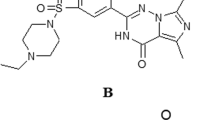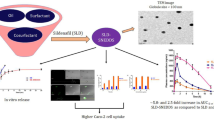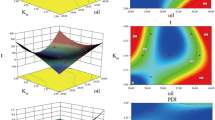Abstract
Vardenafil hydrochloride is commonly used for the curing of erectile dysfunction. VAR suffers certain limitations: (i) short elimination half-life (4–5 h), (ii) low aqueous solubility (0.11 mg/mL), (iii) susceptibility to extensive first-pass metabolism and drug efflux transporters (p-glycoprotein), and (iv) limited (15%) oral bioavailability. The current study focused on the development of VAR lipomers as promising modified release systems able to enhance oral bioavailability. VAR-lipomers (lipid-polymer complexes) were successfully developed by a modified precipitation technique employing a lipid (polyglyceryl-6-distearate or glyceryl tristearate) and an amphiphilic polymer (Gantrez®). Three VAR:lipid ratios [1:1, 1:2, and 1:3] and three VAR:Gantrez® ratios [4:1, 2:1, and 1:1] were investigated. Solid-state characterization studies involved differential scanning calorimetry (DSC), X-ray diffraction (XRD), and Fourier-transform infrared (FT-IR) spectroscopy. The systems were assessed for particle size, polydispersity index (PDI), zeta-potential, VAR entrapment-efficiency (EE%), morphology, and VAR released % after 2 h (Q2h) and 8 h (Q8h). The best-achieved system (the highest desirability) was promoted for pharmacokinetic studies in fasted rabbits. Statistical analysis of data revealed that L9 system (PGDS, VAR, and Gantrez®; 3:1:1, respectively) had the highest desirability (0.85) with respect to spherical particle size (622.15 nm), PDI (0.11), zeta-potential (−27.90 mV), EE% (62.80%), Q2h (43.45%), and Q8h (77.40%). With respect to Levitra® tablets, the significantly higher relative bioavailability (170%), delayed Tmax, and extended MRT(0–∞) clarified the dual ability of L9 system. Lipomers are emerging systems capable of modifying the rate of VAR release and promoting its oral bioavailability.





Similar content being viewed by others
References
Ashour AE, Motiur Rahman AFM, Kassem MG. Vardenafil dihydrochloride. In: Brittain HG, editor. Profiles of drug substances, excipients and related methodology. San Diego: Academic Press; 2014. p. 515–44.
Keating GM, Scott LJ. Vardenafil: a review of its use in erectile dysfunction. Drugs. 2003;63(23):2673–703.
Choi MK, Song IS. Characterization of efflux transport of the PDE5 inhibitors, vardenafil and sildenafil. J Pharm Pharmacol. 2012;64(8):1074–83.
Moffat AC, Osselton MD, Widdop B. Clarke’s analysis of drugs and poisons. 4th ed. London: The Pharmaceutical Press; 2011.
Sanford M. Vardenafil orodispersible tablet. Drugs. 2012;72(1):87–98.
Fahmy U. Nanoethosomal transdermal delivery of vardenafil for treatment of erectile dysfunction: optimization, characterization, and in vivo evaluation. Drug Des Devel Ther. 2015;9:6129–37.
Berry B, Altman P, Rowe J, Vaisman J. Comparison of pharmacokinetics of vardenafil administered using an ultrasonic nebulizer for inhalation vs a single 10-mg oral tablet. J Sex Med. 2016;13(7):1111–8.
Tawfik MA, Tadros MI, Mohamed MI. Polyamidoamine (PAMAM) dendrimers as potential release modulators and oral bioavailability enhancers of vardenafil hydrochloride. Pharm Dev Technol. 2018;21:1–10.
Wu XY. Strategies for optimizing polymer-lipid hybrid nanoparticle-mediated drug delivery. Expert Opin Drug Deliv. 2016;13(5):609–12.
Benival DM, Devarajan PV. Lipomer of doxorubicin hydrochloride for enhanced oral bioavailability. Int J Pharm. 2012;423(2):554–61.
Li Y, Taulier N, Rauth AM, Wu XY. Screening of lipid carriers and characterization of drug-polymer-lipid interactions for the rational design of polymer-lipid hybrid nanoparticles (PLN). Pharm Res. 2006;23(8):1877–87.
Guhagarkar SA, Gaikwad RV, Samad A, Malshe VC, Devarajan PV. Polyethylene sebacate-doxorubicin nanoparticles for hepatic targeting. Int J Pharm. 2010;401(1–2):113–22.
Wong HL, Bendayan R, Rauth AM, Wu XY. Development of solid lipid nanoparticles containing ionically complexed chemotherapeutic drugs and chemosensitizers. J Pharm Sci. 2004;93(8):1993–2004.
Mieszawska AJ, Gianella A, Cormode DP, Zhao Y, Meijerink A, Langer R, et al. Engineering of lipid-coated PLGA nanoparticles with a tunable payload of diagnostically active nanocrystals for medical imaging. Chem Commun (Camb). 2012;48(47):5835–7.
Moon JJ, Suh H, Polhemus ME, Ockenhouse CF, Yadava A, Irvine DJ. Antigen-displaying lipid-enveloped PLGA nanoparticles as delivery agents for a plasmodium vivax malaria vaccine. PLoS One. 2012;7(2):e31472.
Li J, He Y, Li W, Shen Y, Li Y, Wang Y. A novel polymer-lipid hybrid nanoparticle for efficient nonviral gene delivery. Acta Pharmacol Sin. 2010;31(4):509–14.
Wong HL, Rauth AM, Bendayan R, Manias JL, Ramaswamy M, Liu Z, et al. A new polymer-lipid hybrid nanoparticle system increases cytotoxicity of doxorubicin against multidrug-resistant human breast cancer cells. Pharm Res. 2006;23(7):1574–85.
Wong HL, Rauth AM, Bendayan R, Wu XY. In vivo evaluation of a new polymer-lipid hybrid nanoparticle (PLN) formulation of doxorubicin in a murine solid tumor model. Eur J Pharm Biopharm. 2007;65(3):300–8.
Wong HL, Bendayan R, Rauth AM, Xue HY, Babakhanian K, Wu XY. A mechanistic study of enhanced doxorubicin uptake and retention in multidrug resistant breast cancer cells using a polymer-lipid hybrid nanoparticle system. J Pharmacol Exp Ther. 2006;317(3):1372–81.
Devarajan PV, Jindal AB, Patil RR, Mulla F, Gaikwad RV, Samad A. Particle shape: a new design parameter for passive targeting in splenotropic drug delivery. Int J Pharm. 2010;99(6):2576–81.
Patil RR, Guhagarkar SA, Devarajan PV. Engineered nanocarriers of doxorubicin: a current update. Crit Rev Ther Drug Carrier Syst. 2008;25(1):1–61.
Patil RR, Gaikwad RV, Samad A, Devarajan PV. Role of lipids in enhancing splenic uptake of polymer-lipid (LIPOMER) nanoparticles. J Biomed Nanotechnol. 2008;4(3):359–66.
Salman HH, Gamazo C, De Smidt PC, Russell-Jones G, Irache JM. Evaluation of bioadhesive capacity and immunoadjuvant properties of vitamin B12-Gantrez nanoparticles. Pharm Res. 2008;25(12):2859–68.
Salman HH, Gamazo C, Campanero MA, Irache JM. Salmonella-like bioadhesive nanoparticles. J Control Release. 2005;106:1–2):1–13.
Salman HH, Gamazo C, Campanero MA, Irache JM. Bioadhesive mannosylated nanoparticles for oral drug delivery. J Nanosci Nanotechnol. 2006;6(9–10):3203–9.
Bargoni A, Cavalli R, Zara GP, Fundarò A, Caputo O, Gasco MR. Transmucosal transport of tobramycin incorporated in solid lipid nanoparticles (SLN) after duodenal administration to rats. Part II-tissue distribution. Pharmacol Res. 2001;43(5):497–502.
Eldridge JH, Hammond CJ, Meulbroek JA, Staas JK, Gilley RM, Tice TR. Controlled vaccine release in the gut-associated lymphoid tissues. I. Orally administered biodegradable microspheres target the peyer’s patches. J Control Release. 1990;11(1–3):205–14.
Vandamme TF, Ngombo Mukendi JF. Controlled release of levamisole from poly-(ε-caprolactone) matrices II. Effects of water-soluble polymer and iron powder incorporated into the matrices. Int J Pharm. 1996;132:153–63.
Tayel SA, El-Nabarawi MA, Tadros MI, Abd-Elsalam WH. Duodenum-triggered delivery of pravastatin sodium: II. Design, appraisal and pharmacokinetic assessments of enteric surface-decorated nanocubosomal dispersions. Drug Deliv. 2016;23(9):3266–78.
Abd-Elbary A, Tadros MI, Alaa-Eldin AA. Sucrose stearate-enriched lipid matrix tablets of etodolac: modulation of drug release, diffusional modeling and structure elucidation studies. AAPS PharmSciTech. 2013;14(2):656–68.
Dragicevic-Curic N, Scheglmann D, Albrecht V, Fahr A. Development of different temoporfin-loaded invasomes-novel nanocarriers of temoporfin: characterization, stability and in vitro skin penetration studies. Colloids Surf B Biointerfaces. 2009;70(2):198–206.
Lee HM, Kim CS, Jang YM, Kwon SW, Lee BJ. Separation and structural elucidation of a novel analogue of vardenafil included as an adulterant in a dietary supplement by liquid chromatography-electrospray ionization mass spectrometry, infrared spectroscopy and nuclear magnetic resonance spectroscopy. J Pharm Biomed Anal. 2011;54(3):491–6.
The United States Pharmacopeial Convention. United States Pharmacopeia (USP 36) and National Formulary (NF 31) (Omeprazole delayed release capsules). Rockville, MD; 2013.
Bischoff E, Niewoehner U, Haning H, Es Sayed M, Schenke T, Schlemmer KH. The oral efficacy of vardenafil hydrochloride for inducing penile erection in a conscious rabbit model. J Urol. 2001;165(4):1316–8.
Hosny KM, Aljaeid BM. Sildenafil citrate as oral solid lipid nanoparticles: a novel formula with higher bioavailability and sustained action for treatment of erectile dysfunction. Expert Opin Drug Deliv. 2014;11(7):1015–22.
Lake ST, Altman PM, Vaisman J, Addison RS. Validated LC-MS/MS assay for the quantitative determination of vardenafil in human plasma and its application to a pharmacokinetic study. Biomed Chromatogr. 2010;24(8):846–51.
Johnson RD, Lewis RJ, Angier MK. The LC/MS quantitation of vardenafil (Levitra®) in postmortem biological specimens. Federal Aviation Administration (FAA) Civil Aerospace Medical Institute; technical report documentation no. DOT/FAA/AM-06/17. 2006.
Abd-Elbary A, Tadros MI, Alaa-Eldin AA. Development and in vitro/in vivo evaluation of etodolac controlled porosity osmotic pump tablets. AAPS PharmSciTech. 2011;12(2):485–95.
Layre AM, Couvreur P, Chacun H, Aymes-Chodur C, Ghermani NE, Poupaert J, et al. Busulfan loading into poly (alkyl cyanoacrylate) nanoparticles: physico-chemistry and molecular modeling. J Biomed Mater Res B Appl Biomater. 2006;79((2):254–62.
Sweetman S. Martindale: the complete drug reference. 36th ed. London: Pharmaceutical Press; 2009.
Cachile M, Cazabat AM, Bardon S, Valignat MP, Vandenbrouck F. Spontaneous spreading of surfactant solutions on hydrophilic surfaces. Colloids Surf A Physicochem Eng Asp. 1999;159(1):47–56.
Tadros MI, Al-Mahallawi AM. Long-circulating lipoprotein-mimic nanoparticles for smart intravenous delivery of a practically-insoluble antineoplastic drug: development, preliminary safety evaluations and preclinical pharmacokinetic studies. Int J Pharm. 2015;493(1–2):439–50.
Garanti T, Stasik A, Burrow AJ, Alhnan MA, Wan KW. Anti-glioma activity and the mechanism of cellular uptake of Asiatic acid-loaded solid lipid nanoparticles. Int J Pharm. 2016;500(1–2):305–15.
Liu Y, Pan J, Feng SS. Nanoparticles of lipid monolayer shell and biodegradable polymer core for controlled release of paclitaxel: effects of surfactants on particles size, characteristics and in vitro performance. Int J Pharm. 2010;395(1–2):243–50.
Muller RH, Mader K, Gohla S. Solid lipid nanoparticles (SLN) for controlled drug delivery: a review of the state of the art. Eur J Pharm Biopharm. 2000;50(1):161–77.
Li Y, Wong HL, Shuhendler AJ, Rauth AM, Wu XY. Molecular interactions, internal structure and drug release kinetics of rationally developed polymer-lipid hybrid nanoparticles. J Control Release. 2008;128(1):60–70.
Author information
Authors and Affiliations
Corresponding author
Ethics declarations
Conflict of Interest
The authors declare that they have no conflict of interest.
Additional information
Guest Editor: Sanyog Jain
Rights and permissions
About this article
Cite this article
Tawfik, M.A., Tadros, M.I. & Mohamed, M.I. Lipomers (Lipid-polymer Hybrid Particles) of Vardenafil Hydrochloride: a Promising Dual Platform for Modifying the Drug Release Rate and Enhancing Its Oral Bioavailability. AAPS PharmSciTech 19, 3650–3660 (2018). https://doi.org/10.1208/s12249-018-1191-0
Received:
Accepted:
Published:
Issue Date:
DOI: https://doi.org/10.1208/s12249-018-1191-0




